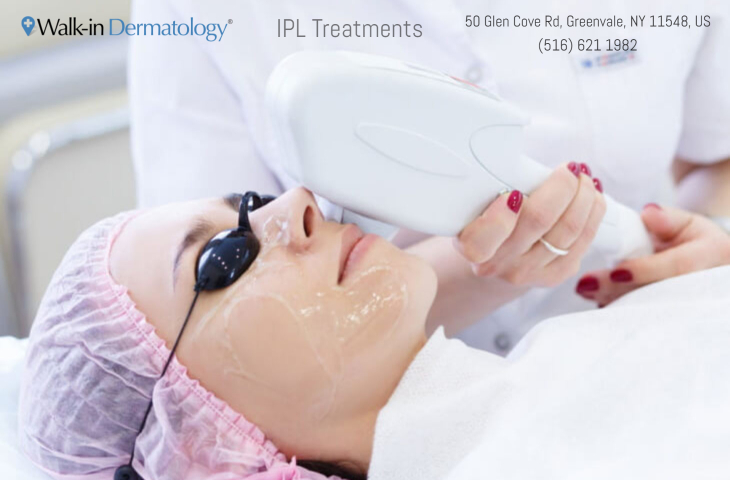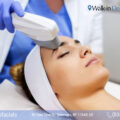Tues: 8:30am - 3:00pm
Wed: 12:00pm - 6:00pm
Thurs: 8:30am - 3:00pm
Fri: Closed
Sat: 8:30am - 12:30pm
Sun: Closed
Greenvale, NY 11548
What Can I Expect after a Photofacial?


Photofacial therapy, also known as Intense Pulsed Light or IPL, is a proven non-surgical technique for stopping the clock on aging skin and restoring a more youthful appearance.
IPL works by directing pulsating light energy into the skin. The light converts to heat as it reaches its target, which can be pigment in the skin or hair, redness caused by blood vessels, even the bacteria in acne. The goal of treatment is to remove blemishes and imperfections in the skin, or in more severe cases at least make them less noticeable. Photofacial treatments produce excellent results with minimal downtime and discomfort.
Immediately after a photofacial treatment, there may be some mild redness and swelling, which can be covered with makeup. Most patients can apply makeup immediately after the procedure, although your dermatologist may recommend waiting a day or two. Patients are able to return to work or resume normal activities right away. Discoloration may be noticeable in the treated areas. This is normal. The discoloration will disappear in a week or two as the skin cells in the treated area rise to the surface and flake off.
You’ll see improvement about a week after each treatment. Most patients need 3 to 5 photofacial sessions. Maximum results will be noticeable in 3 to 5 months if you receive a series of IPL treatments about a month apart between each session.
Side effects of photofacial therapy are typically minor and temporary.
How photofacial therapy improves sun-damaged skin
A photofacial erases the effects of UV damage in two ways: First, it penetrates and dissolves discolored cells that have formed deep in the skin. The result is more even and well-toned skin. Think of the process as a deep exfoliation. After each photofacial session, during the healing process your skin begins to generate new collagen, which makes your skin stronger and smoother.
Regular photofacials spaced a month or more apart can stop premature skin aging
Photofacials change the structure of your skin cells, causing them to respond more like young cells. A 10-year study at Stanford University showed that having 2 to 3 photofacials annually for a decade positively altered the genes of skin cells. Regular IPL treatments transformed cell production into young, healthy skin cells.
To get the most benefit from the therapy, after each session you must avoid exposure to the sun. Skin resurfacing therapies, including photofacials, will temporarily make your skin more sun sensitive. Using sunscreen before and after photofacial treatments is likewise important.
A healthy diet is also essential to maintain weight. Gaining or losing weight during photofacial therapy has the tendency to distort the skin, either by stretching or loosening, which undoes the positive photofacial effect of collagen production.
Photofacial therapy can also be used in tandem with other treatments
The revitalizing effects of photofacial therapy can be combined with other non-surgical procedures such as dermal fillers and Botox injections, which can be used on skin areas that photofacials cannot treat, such as around the eyes.
What to expect after IPL:
- Redness around the treated area for two to five days
- Minor bruising that may last two weeks or less
- Freckles and age spots may darken for three to seven days before starting to fade
- Skin flaking and crusting for up to 10 days
- A sensation of sunburn for two to five hours immediately after treatment
Most patients experience some, but seldom all, of these after-effects. Discomfort is generally minor.
What you can do to speed up healing after IPL therapy:
- Use mild cleansers and moisturizers daily on your skin.
- Apply a sunscreen with a minimum of 30 SPF. This protects your skin from UVB and UVA rays.
- Cleanse your skin twice a day with warm water.
- Perform a microdermabrasion facial 2 to 3 weeks after treatment with IPL. This protects and hydrates your skin while removing dead skin cells.
- Add stem cell serum to your skin regimen to boost collagen repair, and give your skin a smooth and healthy appearance.
What to avoid after IPL therapy:
- No hot showers for 48 hours.
- For 2 days after a treatment avoid taking aspirin, Ibuprofen, drinking alcohol, heavy exertion and activities which may cause skin flushing.
- Avoid harsh topical products such as retinols and glycolic acid products for one week after each session.
- Avoid direct sunlight on the treated area and use a sunscreen with SPF 30 or greater for 4 to 6 weeks after treatment.
- No swimming for a week, especially in pools with chemicals such as chlorine.
- No strenuous exercise for 48 hours. You can hit the gym after about 2 days post-therapy.
- No hot tubs or Jacuzzis for 48 hours.
- Avoid activities that cause excessive perspiration.
- Do not pick at or remove any loosening or peeling skin.
- No electrolysis, facial waxing or depilatories (hair removal products) for 14 days after a treatment.
It is important to give your skin some TLC after your photofacial session. Your skin will probably feel sensitive, especially to heat. This is why regular use of a moisturizer and sunscreen will not only make your skin feel better but will hasten the rejuvenation process of IPL therapy.
Getting the best photofacial treatment
You don’t have to look far for excellent dermatology services – including IPL therapy and other cosmetic treatments. Best of all, now there’s no waiting.
In many parts of New York and throughout the country, patients often wait weeks before they can see a board-certified dermatologist and receive a diagnosis, much less actual treatment.
That’s no longer necessary.
At Walk-in Dermatology, patients can see a board-certified dermatologist at a time that’s convenient for them. Our dermatologists will evaluate your skin and answer all your questions. If photofacial therapy seems like the right solution, we will work with you to set up IPL treatments convenient to your schedule.
No more waiting days or even weeks to receive IPL treatments. If you desire a proven, non-surgical way to revitalize your appearance and treat sun damage, wrinkles and lines, rosacea, enlarged pores, scars and much more, Walk-in Dermatology is here to serve you. We are open and ready to help you regain healthy skin that positively glows with a youthful look.
Learn more: What’s Better: IPL or BBL?








